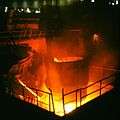Superplastic forming
Superplastic forming is an industrial process used for creating precise and complex components out of superplastic materials.
Process
The material is first heated up to promote superplasticity. For titanium alloys e.g. Ti 6Al 4V and some stainless steels this is around 900 °C (1,650 °F) and for aluminium alloys e.g. AA5083 it is between 450–520 °C. In this state the material becomes soft so processes that are usually used on plastics can be applied, such as: thermoforming, blow forming, and vacuum forming.[1] Inert gas pressure is applied on the superplastic sheet forcing it into a female die.
Advantages and disadvantages
The major advantage of this process is that it can form large and complex workpieces in one operation. The finished product has excellent precision and a fine surface finish. It also does not suffer from springback or residual stresses. Products can also be made larger to eliminate assemblies or reduce weight, which is critical in aerospace applications.[1] Lower strength required and less tooling costs. McDonnell Douglas utilized SPF design and production technology into the F-15 in the 1980s.
The largest disadvantage of the process is its slow forming rate. Cycle times vary from two minutes to two hours, therefore it is usually used in low volume production applications.[2][1] Another disadvantage is the non-uniformity of the produced part thickness.[3] Several methods are used to improve the thickness uniformity of SPF parts. One is to apply a designed varying gas pressure profile instead of a constant pressure.[4] Another approach is to tailor the contact friction between the die surface and the superplastic sheet.[5]
References
- E. Degarmo, J. Black, and R. Kohser, Materials and Processes in Manufacturing (9th ed.), 2003, Wiley, ISBN 0-471-65653-4.
- Jarrar, Firas; Jafar, Reem; Tulupova, Olga; Enikeev, Farid; Al-Huniti, Naser (January 2016). "Constitutive Modeling for the Simulation of the Superplastic Forming of AA5083". Materials Science Forum. 838-839: 512–517. doi:10.4028/www.scientific.net/MSF.838-839.512. ISSN 1662-9752.
- F. Jarrar, M. Liewald, P. Schmid, and A. Fortanier, Superplastic Forming of Triangular Channels with Sharp Radii, Journal of Materials Engineering and Performance, 2014, 23(4), p 1313-1320.
- F.S. Jarrar, L.G. Hector Jr., M.K. Khraisheh, and K. Deshpande, Gas Pressure Profile Prediction from Variable Strain Rate Deformation Paths in AA5083 Bulge Forming, Journal of Materials Engineering and Performance, 2012, 21(11), p 2263–2273.
- 12. M.I. Albakri, F.S. Jarrar, and M.K. Khraisheh, Effects of Interfacial Friction Distribution on the Superplastic Forming of AA5083, Journal of Engineering Materials and Technology, 2011, 133, p 031008-031014.
